Samsung UN40C5000, BN68-02625B-02 User Manual

Contact SAMSUNG WORLDWIDE
If you have any questions or comments relating to Samsung products, please contact the SAMSUNG customer care center.
Comment contacter Samsung dans le monde
Si vous avez des suggestions ou des questions concernant les produits Samsung, veuillez contacter le Service Consommateurs Samsung.
Country |
Customer Care Center |
Web Site |
Address |
CANADA |
1-800-SAMSUNG (726-7864) |
www.samsung.com |
Samsung Electronics Canada Inc., Customer Service |
|
|
|
55 Standish Court Mississauga, Ontario L5R 4B2 |
|
|
|
Canada |
U.S.A |
1-800-SAMSUNG (726-7864) |
www.samsung.com |
Samsung Electronics America, Inc. 105 Challenger |
|
|
|
Road Ridgefield Park, NJ 07660-0511 |
manual user TV LED
LED TV
user manual
imagine the possibilities
Thank you for purchasing this Samsung product. To receive more complete service, please register your product at
www.samsung.com/register
Model______________ Serial No.______________
© 2010 Samsung Electronics Co., Ltd. All rights reserved. |
BN68-02625B-02 |
|

Figures and illustrations in this User Manual are provided for reference only and may differ from actual product appearance. Product design and specifications may be changed without notice.
Important Warranty Information Regarding Television Format Viewing
See the warranty card for more information on warranty terms.
Wide screen format LED Displays (16:9, the aspect ratio of the screen width to height) are primarily designed to view wide screen format full-motion video. The images displayed on them should primarily be in the wide screen 16:9 ratio format, or expanded to fill the screen if your model offers this feature and the images are constantly moving. Displaying stationary graphics and images on screen, such as the dark sidebars on no nexpanded standard format television video and programming, should be limited to no more than 5% of the total television viewing per week.
Additionally, viewing other stationary images and text such as stock market reports, video game displays, station logos, web sites or computer graphics and patterns, should be limited as described above for all televisions. Displaying stationary images that exceed the above guidelines can cause uneven aging of LED Displays that leave subtle, but permanent burned-in ghost images in the LED picture. To avoid this, vary the programming and images, and primarily display full screen moving images, not stationary patterns or dark bars. On LED models that offer picture sizing features, use these controls to view different formats as a full screen picture.
Be careful in the selection and duration of television formats used for viewing. Uneven LED aging as a result of format selection and use, as well as burned in images, are not covered by your Samsung limited warranty.
•SAMSUNG ELECTRONICS NORTH AMERICAN LIMITED WARRANTY STATEMENT
Subject to the requirements, conditions, exclusions and limitations of the original Limited Warranty supplied with Samsung Electronics (SAMSUNG) products, and the requirements, conditions, exclusions and limitations contained herein, SAMSUNG will additionally provide Warranty Repair Service in the United States on SAMSUNG products purchased in Canada, and in Canada on SAMSUNG products purchased in the United States, for the warranty period originally specified, and to the Original Purchaser only.
The above described warranty repairs must be performed by a SAMSUNG Authorized Service Center. Along with this Statement, the Original Limited Warranty Statement and a dated Bill of Sale as Proof of Purchase must be presented to the Service Center. Transportation to and from the Service Center is the responsibility of the purchaser. Conditions covered are limited only to manufacturing defects in material or workmanship, and only those encountered in normal use of the product.
Excluded, but not limited to, are any originally specified provisions for, in-home or on-site services, minimum or maximum repair times, exchanges or replacements, accessories, options, upgrades, or consumables.
For the location of a SAMSUNG Authorized Service Center, please call toll-free:
–In the United States: 1-800-SAMSUNG (1-800-726-7864)
–In Canada: 1-800-SAMSUNG
Still image warning
Avoid displaying still images (such as jpeg picture files) or still image elements (such as TV channel logos, panorama or 4:3 image format, stock or news bars at screen bottom etc.) on the screen. Constant displaying of still picture can cause ghosting of LED screen, which will affect image quality. To reduce risk of this effect, please follow below recommendations:
•Avoid displaying the same TV channel for long periods.
•Always try to display a full screen image.
•Reducing brightness and contrast will help to avoid the appearance of after-images.
•Use all TV features designed to reduce image retention and screen burn, refer to proper user manual section for details.
Securing the Installation Space
Keep the required distances between the product and other objects (e.g. walls) to ensure proper ventilation.
Failing to do so may result in fire or a problem with the product due to an increase in the internal temperature of the product.
When using a stand or wall-mount, use parts provided by Samsung Electronics only.
xx If you use parts provided by another manufacturer, it may result in a problem with the product or an injury due to the product falling.The appearance may differ depending on the product.
Installation with a stand. |
Installation with a wall-mount. |
 4 inches
4 inches
4 inches |
4 inches |
|
4 inches |
4 inches |
4 inches |
|
4 inches |
2 English

Contents |
|
|
Getting Started |
|
|
yy |
List of Features ......................................................... |
4 |
yy |
Accessories............................................................... |
4 |
yy |
Install the Stand......................................................... |
5 |
yy Viewing the Control Panel.......................................... |
6 |
|
yy Viewing the Remote Control...................................... |
7 |
|
yy Connecting to an Antenna......................................... |
8 |
|
yy Plug & Play (Initial Setup)........................................... |
8 |
|
Connections |
|
|
yy Connecting to an AV Device...................................... |
9 |
|
yy Connecting to an Audio Device................................ |
11 |
|
yy Connecting to a PC................................................. |
11 |
|
yy Changing the Input Source...................................... |
13 |
|
Basic Features |
|
|
yy How to Navigate Menus.......................................... |
13 |
|
yy |
Channel Menu......................................................... |
14 |
|
Seeing Channels |
14 |
|
Using Favorite Channels |
14 |
|
Memorizing Channels |
14 |
|
Editing Channels |
15 |
|
Other Features |
15 |
yy |
Picture Menu........................................................... |
16 |
|
Changing the Preset Picture Mode |
16 |
|
Adjusting Picture Settings |
16 |
|
Economical Solutions |
16 |
|
Changing the Picture Options |
17 |
|
Setting up the TV with Your PC |
18 |
yy |
Sound Menu............................................................ |
19 |
|
Changing the Preset Sound Mode |
19 |
|
Adjusting Sound Settings |
19 |
|
Sound Settings |
19 |
yy |
Setup Menu............................................................. |
20 |
|
Setting the Time |
20 |
|
Using the Sleep Timer |
20 |
|
Setting the On / Off Timer |
20 |
|
Locking Programs |
21 |
|
Other Features |
22 |
|
Picture In Picture (PIP) |
23 |
yy |
Support Menu......................................................... |
24 |
Advanced Features |
|
|
yy |
Network Connection................................................ |
25 |
|
Connecting to a Wired Network |
25 |
|
Connecting to a Wireless Network |
27 |
yy |
Media Play............................................................... |
31 |
|
Connecting a USB Device |
31 |
|
Connecting to your PC through a network |
31 |
|
Screen Display |
33 |
|
Playing Multiple Files |
36 |
|
Media Play - Additional Functions |
36 |
yy |
Anynet+................................................................... |
38 |
|
Setting Up Anynet+ |
39 |
|
Switching between Anynet+ Devices |
39 |
|
Recording |
39 |
|
Listening through a Receiver |
40 |
|
Troubleshooting for Anynet+ |
40 |
yy |
AllShare................................................................... |
41 |
|
About AllShare |
41 |
|
Setting Up AllShare |
41 |
Other Information |
|
|
yy |
Assembling the Cables............................................ |
43 |
yy Installing the Wall Mount.......................................... |
44 |
|
yy |
Anti-theft Kensington Lock...................................... |
45 |
yy Securing the TV to the Wall...................................... |
46 |
|
yy |
Troubleshooting....................................................... |
47 |
yy |
License.................................................................... |
49 |
yy |
Specifications.......................................................... |
50 |
yy |
Dimensions.............................................................. |
51 |
yy |
Index....................................................................... |
52 |
Check the Symbol!
TOOLS |
t |
|
|
|
|
Note |
Step by Step Guide |
|
This function can be used by pressing the |
Indicates additional information. |
Check here for instructions on how to open |
|
TOOLS button on the remote control. |
|
the relevant submenu within the OSD (on |
|
|
|
screen display). |
ENGLISH
English 3

Getting Started
List of Features
yy Excellent Digital Interface & Networking: With a built-in HD digital tuner, nonsubscription HD broadcasts can be viewed without a cable box / STB (Set-Top-Box) satellite receiver.
yy Media Play: Allows you to play music files, pictures, and movies saved on a USB device (p. 31).
yy AllShare: AllShare connects your TV and compatible Samsung mobile phones/devices through a network (p. 41). yy Self Diagnosis: You can check picture and sound operate normally (p. 24).
Accessories
Please make sure the following items are included with your LED TV. If any items are missing, contact your dealer.The items' colors and shapes may vary depending on the models.
yy Remote Control (BN59-01041A) & Batteries (AAA x 2) |
yy |
Cleaning Cloth (BN63-01798B) |
|
yy |
Owner’s Instructions |
yy |
Power Cord |
yy |
Warranty Card / Safety Guide / Quick Setup Guide |
|
|
(M4 X |
|
|
Blanking Bracket & Screw (1EA) |
Cable Tie |
Holder-Wire stand |
(BN96-12031D) |
(BN61-05596A) |
(BN61-05491A) |
|
Holder-Ring (4EA) |
Holder-Wire (3EA) |
Power Cord Clamp |
||||
|
(BN61-05280A) |
(BN61-05373A) |
(AA65-30023A) |
||||
Input Cables (Sold Separately) |
|
|
|
|
|||
|
|
|
|
|
|
|
|
|
|
|
|
|
|
|
|
|
|
|
|
|
|
|
|
|
|
|
|
|
|
|
|
|
|
|
|
|
|
|
|
HDMI |
HDMI-DVI |
Component |
Composite (AV) |
Coaxial (RF) |
VGA |
|
|
|
|
|
|
4 English
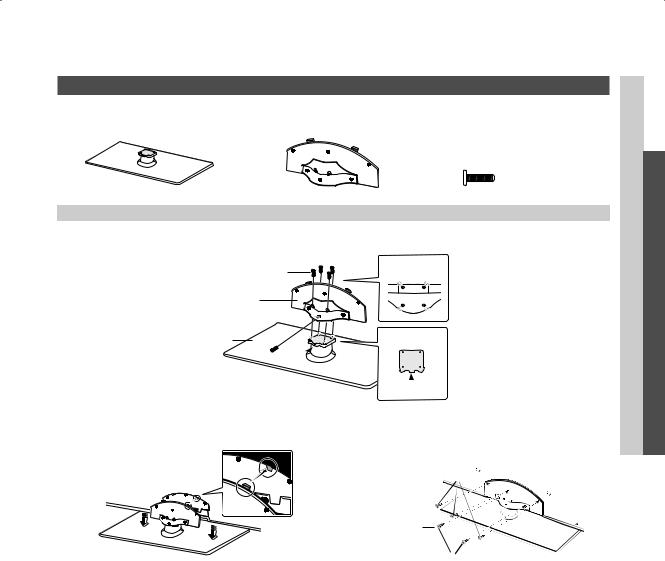
Install the Stand
See separate guide for installing the stand.
|
s |
|
s |
|
|
|
|
|
|
s |
s |
|
|
|
s |
Stand (1EA) |
Guide Stand (1EA) |
||
Follow the steps below to connect the TV to the stand.
Screws (M4 X L16) |
Top view |
|
Guide Stand |
s |
s |
|
||
|
|
s |
Stand |
|
Front |
|
Rear |
Rear |
|
|
|
1. Connect the Guide Stand to the Stand using five screws (M4 X L16) as shown.
(A)  5EA (M4 X L16)
5EA (M4 X L16)
(B) |
5EA (M4 X L8) |
Screws (10EA)
 2
2
s
s
|
s |
|
|
s |
s |
|
|
s |
|
|
|
s |
|
Screws (M4 X L8) |
|
|
|
|
2. With your TV upright, connect the TV to the Stand. |
3. Fasten two screws (M4 X L8) at position 1, and then |
|
fasten three screws (M4 X L8) at position 2. |
NOTE
xx Make sure to distinguish between the front and back of the Stand and Guide Stand when assembling them. xx Make sure that at least two persons lift and move the LED TV.
xx Stand the product up and fasten the screws. If you fasten the screws with the LED TV placed down, it may lean to one side.
 Started Getting 01
Started Getting 01
English 5
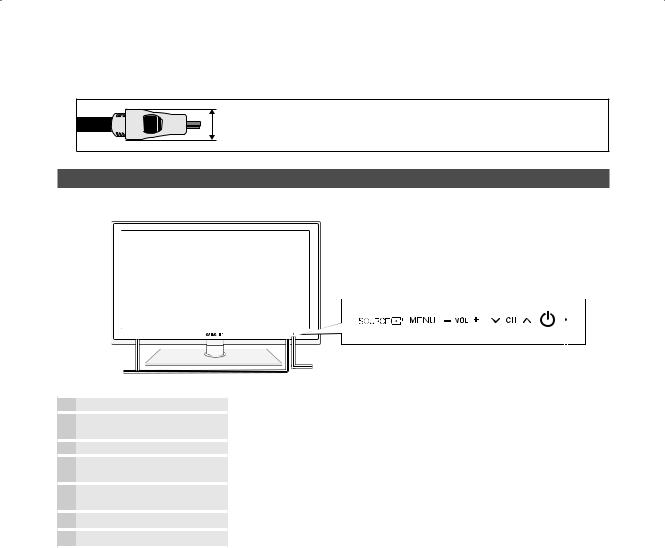
Getting Started
For best cable connection to this product, be sure to use cables with a maximum thickness as below:
yy Maximum thickness - 0.55 inches (14mm)
Viewing the Control Panel
The product color and shape may vary depending on the model.
Speakers
Remote control sensor
SOURCEE
MENU
y
z
P(Power)
Power Indicator
Standby mode
Remote control sensor |
|
|
Power Indicator |
||
Aim the remote control towards this spot on the TV.
Toggles between all the available input sources. In the on-screen menu, use this button as you would use the ENTEREbutton on the remote control.
Displays an on-screen menu, the OSD (on screen display) of your TV’s features.
Adjusts the volume. In the OSD, use the ybuttons as you would use the ◄ and ► buttons on the remote control.
Changes the channels. In the OSD, use the zbuttons as you would use the ▼ and ▲ buttons on the remote control.
Turns the TV on or off.
Blinks and turns off when the power is on and lights up in standby mode.
Do not leave your TV in standby mode for long periods of time (when you are away on a holiday, for example). A small amount of electric power is still consumed even when the power button is turned off. It is best to unplug the power cord.
6 English
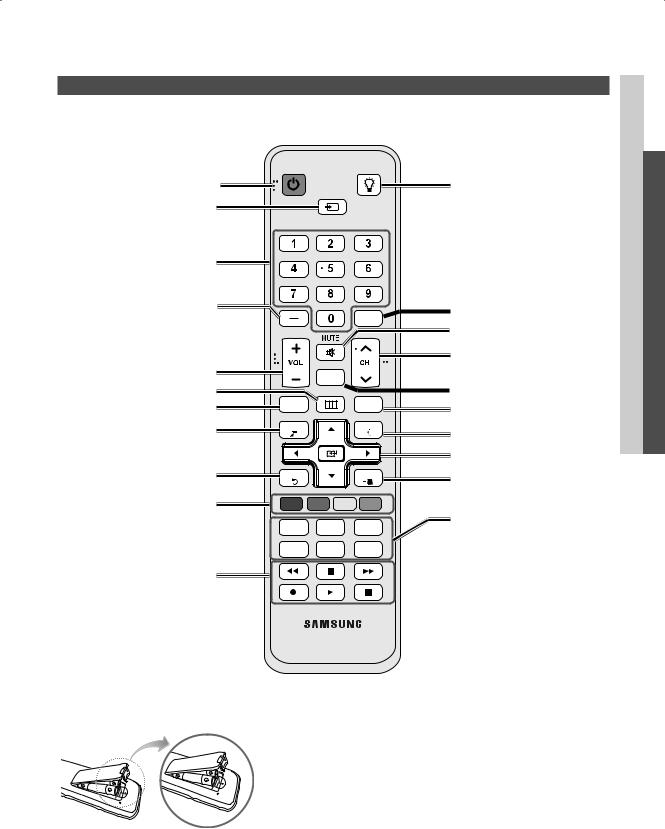
Viewing the Remote Control
This is a special remote control for the visually impaired and has Braille points on the Power, Channel and Volume buttons.
Turns the TV on and off.
Displays and selects the available video sources (p. 13).
Press to directly access channels.
POWER ON/OFF
SOURCE
Turns the remote control light on or off. When on, the buttons become
illuminated for a moment when pressed. (Using the remote control with this button set to ON will reduce the battery usage time.)
 Started Getting 01
Started Getting 01
Press to select additional channels (digital) being broadcasted by the same station. For example, to select channel “54-3”, press “54”, then press “–” and “3”.
Adjusts the volume.
Brings up the OSD.
Views Media Play (USB) (p. 31).
Quickly select frequently used functions.
Returns to the previous menu.
Buttons used in the Channel List,
Media Play (USB) menu, etc.
Use these buttons in Media Play (USB) and Anynet+ (HDMI) modes (p. 31, 38).
( : Controls recording for Samsung recorders that have the Anynet+ feature)
Installing batteries (Battery size: AAA)
PRE-CH
CH LIST
MENU
MEDIA.P FAV.CH
INFO
RETURN EXIT
A B C D
S.MODE SLEEP MTS
P.MODE P.SIZE CC
Returns to the previous channel.
Cuts off the sound temporarily.
Changes channels.
Displays the channel list on the screen (p. 14).
Displays Favorite Channel Lists on the screen (p. 14).
Displays information on the TV screen.
Selects the on-screen menu items and changes the values seen on the menu.
Exits the menu.
S.MODE: Press to select the sound mode (p. 19).
SLEEP: Automatically shuts off the TV at a preset time (p. 20).
MTS: Press to choose stereo, mono or Separate Audio Program (SAP broadcast) (p. 19).
P.MODE: Press to select the picture mode (p. 16).
P.SIZE: Selects the picture size (p. 17). CC: Controls the caption decoder (p. 22).
NOTE
xx Use the remote control within 23 feet from the TV.
xx Bright light may affect the performance of the remote control. Avoid use when nearby fluorescent lights or neon signs.
xx The color and shape may vary depending on the model.
English 7
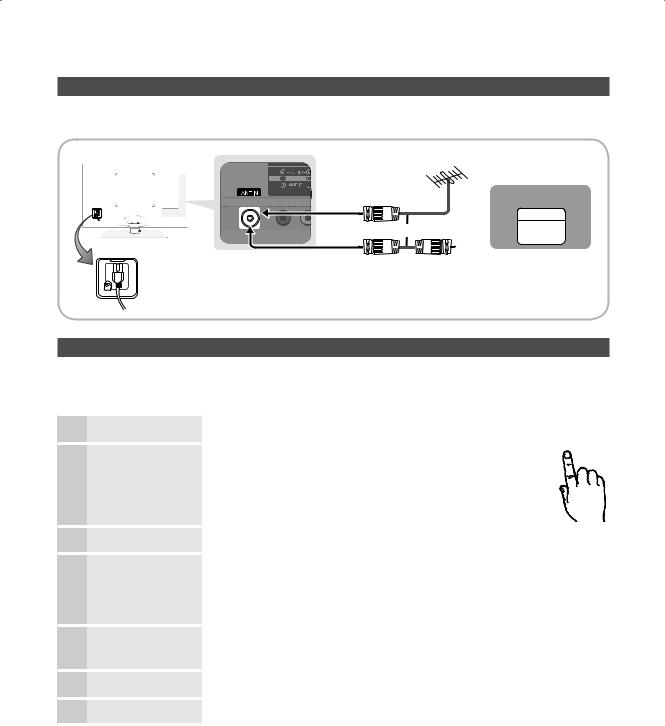
Getting Started
Connecting to an Antenna
When the TV is initially powered on, basic settings proceed automatically.Connecting the power cord and antenna.
VHF/UHF Antenna
Cable
ANT OUT or 
Power Input
Plug & Play (Initial Setup)
When the TV is initially powered on, a sequence of on-screen prompts will assist in configuring basic settings. Press the POWERPbutton. Plug & Play is available only when the Input source is set to TV.
To return to the previous step, press the Red button.
1 |
Selecting a language |
2 |
Selecting Store Demo |
or Home Use |
|
3 |
Selecting an antenna |
4 |
Selecting a channel |
5 |
Setting the |
Clock Mode |
|
6 |
Viewing the |
HD Connection Guide. |
|
7 |
Enjoy your TV. |
Press the ▲ or ▼ button, then press the ENTEREbutton. |
POWER |
|
Select the desired OSD (On Screen Display) language. |
P |
|
Press the ◄ or ► button, then press the ENTEREbutton. |
||
y |
Select the Home Use mode. Store Demo mode is for retail |
|
|
y environments. |
|
yy To return the unit’s settings from Store Demo to Home Use (standard): Press the volume button on the TV. When you
see the volume OSD, press and hold MENU for 5 sec.
Press the ▲ or ▼ button, then press the ENTEREbutton. Select Air, Cable or Auto.
Press the ▲ or ▼ button, then press the ENTEREbutton. Select the channel source to memorize. When setting the antenna source to Cable, a step appears allowing you to
assign numerical values (channel frequencies) to the channels. For more information, refer to
Channel → Auto Program (p. 14).
Press the ENTEREbutton at any time to interrupt the memorization process. Set the Clock Mode automatically or manually.
yy Auto: Allows you to select DST (Daylight Saving Time) mode and time zone. yy Manual: Allows you to manually set the current date and time (p. 20).
The connection method for the best HD screen quality is displayed.
Press the ENTEREbutton.
If You Want to Reset This Feature...
OO MENUm→ Setup → Plug & Play → ENTERE
8 English
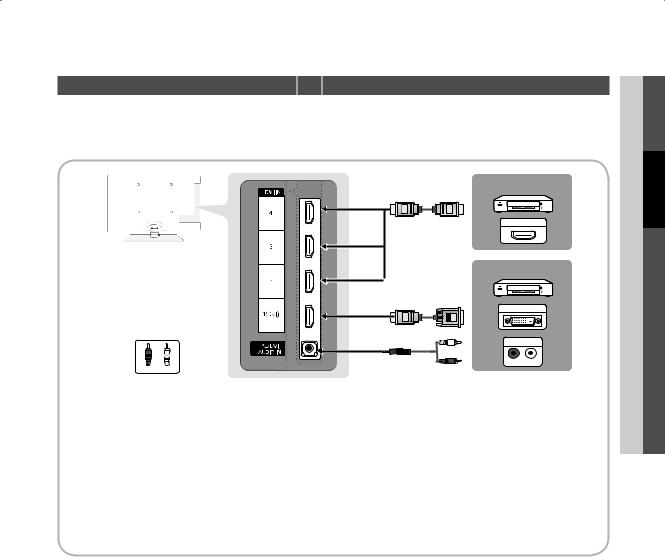
Connections
Connecting to an AV Device
Using an HDMI or HDMI/DVI Cable: HD connection (up to 1080p)
We recommend using the HDMI connection for the best quality HD picture.
Available devices: DVD, Blu-ray player, HD cable box, HD STB (Set-Top-Box) satellite receiver.
|
W |
R |
W |
|
R |
Red White
Device
HDMI OUT
Device
DVI OUT
AUDIO OUT
R-AUDIO-L
HDMI IN 1(DVI), 2, 3, 4, PC/DVI AUDIO IN
xx When using an HDMI/DVI cable connection, you must use the HDMI IN 1(DVI) jack for video. A DVD, Blu-ray player, HD cable box, or HD STB satellite receiver may require a DVI-HDMI (DVI to HDMI) cable or DVI-HDMI (DVI to HDMI) adapter. The PC/DVI AUDIO IN jack is required for audio.
xx Be sure to use an HDMI cable with a thickness of 14 mm or less.
xx The picture may not display normally (if at all) or the audio may not work if an external device that uses an older version of HDMI mode is connected to the TV. If such a problem occurs, ask the manufacturer of the external device about the HDMI version and, if out of date, request an upgrade.
xx Be sure to purchase a certified HDMI cable. Otherwise, the picture may not display or a connection error may occur.
Connections 02
English 9

Connections
Using a Component (up to 1080p) or Audio/Video (480i only) Cable
Available devices: DVD, Blu-ray player, cable box, STB satellite receiver, VCR
R |
W |
Y |
Red White Yellow
Device
Y |
W |
R |
Y |
R |
W |
|
||
VIDEO OUT |
AUDIO OUT |
|
|
R-AUDIO-L |
|
R |
W |
R |
B |
G |
R |
W |
R |
B |
G |
AUDIO OUT |
COMPONENT OUT |
|||
R-AUDIO-L |
|
PR |
PB |
G |
R W R B G
Red White Red Blue Green
Device
When connecting to AV IN, the color of the AV IN [Y/VIDEO] jack (green) will not match the video cable (yellow).For better picture quality, the Component connection is recommended over the A/V connection.
Using an EX-Link Cable Connection
Available Devices: External devices that support EX-Link
EX-LINK: Connector for service only.
10 English

Connecting to an Audio Device
Using an Optical (Digital) or Audio (Analog) Cable Connection
Available devices: Digital Audio System, Amplifier, DVD home theater
R W
Red White
Amplifier,
AUDIO IN DVD home theater
R-AUDIO-L
Digital Audio System
OPTICAL
DIGITAL AUDIO OUT (OPTICAL)
xx When a Digital Audio System is connected to the DIGITAL AUDIO OUT (OPTICAL) jack, decrease the volume of both the TV and the system.
xx 5.1 CH (channel) audio is available when the TV is connected to an external device supporting 5.1 CH.
xx When the receiver (home theater) is set to on, you can hear sound output from the TV’s optical jack. When the TV is receiving a DTV signal, the TV will send 5.1 CH sound to the home theater receiver. When the source is a digital component such as a DVD / Blu-ray player / cable box / STB (Set-Top-Box) satellite receiver and is connected to the TV via HDMI, only 2 CH audio will be heard from the home theater receiver. If you want to hear 5.1 CH audio, connect the digital audio out jack from your DVD / Blu-ray player / cable box / STB satellite receiver directly to an amplifier or home theater.
AUDIO OUT: Connects to the audio input jacks on your amplifier/home theatre. xx When connecting, use the appropriate connector.
xx When an audio amplifier is connected to the AUDIO OUT jacks: Decrease the volume of the TV and adjust the volume level with the amplifier's volume control.
Connecting to a PC
Using an HDMI/DVI cable or a D-sub cable
DVI OUT
AUDIO OUT
AUDIO OUT
PC OUT
Connections 02
English 11

Connections
Display Modes (D-Sub and HDMI/DVI Input)
Optimal resolution is 1920 X 1080 @ 60 Hz.
Mode |
Resolution |
Horizontal Frequency |
Vertical Frequency |
Pixel Clock Frequency |
Sync Polarity |
|
(KHz) |
(Hz) |
(MHz) |
(H / V) |
|||
|
|
|||||
IBM |
640 x 350 |
31.469 |
70.086 |
25.175 |
+/- |
|
720 x 400 |
31.469 |
70.087 |
28.322 |
-/+ |
||
|
||||||
|
|
|
|
|
|
|
|
640 x 480 |
35.000 |
66.667 |
30.240 |
-/- |
|
MAC |
832 x 624 |
49.726 |
74.551 |
57.284 |
-/- |
|
|
1152 x 870 |
68.681 |
75.062 |
100.000 |
-/- |
|
|
720 x 576 |
35.910 |
59.950 |
32.750 |
-/+ |
|
VESA CVT |
1152 x 864 |
53.783 |
59.959 |
81.750 |
-/+ |
|
1280 x 720 |
56.456 |
74.777 |
95.750 |
-/+ |
||
|
||||||
|
1280 x 960 |
75.231 |
74.857 |
130.000 |
-/+ |
|
|
640 x 480 |
31.469 |
59.940 |
25.175 |
-/- |
|
|
640 x 480 |
37.861 |
72.809 |
31.500 |
-/- |
|
|
640 x 480 |
37.500 |
75.000 |
31.500 |
-/- |
|
|
800 x 600 |
37.879 |
60.317 |
40.000 |
+/+ |
|
|
800 x 600 |
48.077 |
72.188 |
50.000 |
+/+ |
|
|
800 x 600 |
46.875 |
75.000 |
49.500 |
+/+ |
|
|
1024 x 768 |
48.363 |
60.004 |
65.000 |
-/- |
|
|
1024 x 768 |
56.476 |
70.069 |
75.000 |
-/- |
|
|
1024 x 768 |
60.023 |
75.029 |
78.750 |
+/+ |
|
VESA DMT |
1152 x 864 |
67.500 |
75.000 |
108.000 |
+/+ |
|
1280 x 1024 |
63.981 |
60.020 |
108.000 |
+/+ |
||
|
||||||
|
1280 x 1024 |
79.976 |
75.025 |
135.000 |
+/+ |
|
|
1280 x 720 |
45.000 |
60.000 |
74.250 |
+/+ |
|
|
1280 x 800 |
49.702 |
59.810 |
83.500 |
-/+ |
|
|
1280 x 800 |
62.795 |
74.934 |
106.500 |
-/+ |
|
|
1280 x 960 |
60.000 |
60.000 |
108.000 |
+/+ |
|
|
1360 x 768 |
47.712 |
60.015 |
85.500 |
+/+ |
|
|
1440 x 900 |
55.935 |
59.887 |
106.500 |
-/+ |
|
|
1440 x 900 |
70.635 |
74.984 |
136.750 |
-/+ |
|
|
1680 x 1050 |
65.290 |
59.954 |
146.250 |
-/+ |
|
VESA GTF |
1280 x 720 |
52.500 |
70.000 |
89.040 |
-/+ |
|
1280 x 1024 |
74.620 |
70.000 |
128.943 |
-/- |
||
|
||||||
|
|
|
|
|
|
|
VESA DMT / DTV CEA |
1920 x 1080p |
67.500 |
60.000 |
148.500 |
+/+ |
|
|
|
|
|
|
|
NOTE
xx For HDMI/DVI cable connection, you must use the HDMI IN 1(DVI) jack. xx The interlace mode is not supported.
xx The set may operate abnormally if a non-standard video format is selected.
xx Separate and Composite modes are supported. SOG(Sync On Green) is not supported.
12 English
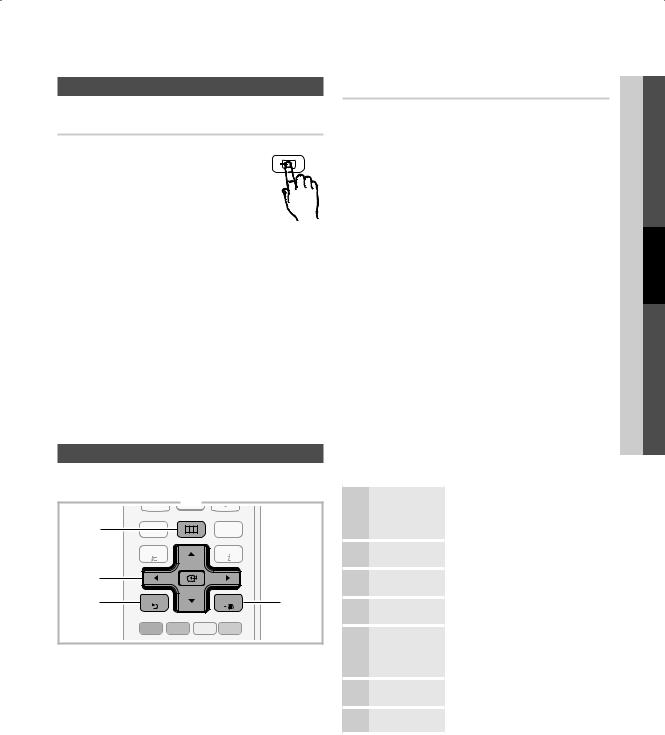
Changing the Input Source
Source List
Use to select TV or an external input sources |
SOURCE |
such as a DVD / Blu-ray player / cable box / |
|
STB satellite receiver. |
|
OO MENUm→ Input → Source List →
ENTERE
■■ TV / PC / AV / Component / HDMI1/DVI / HDMI2 / HDMI3 / HDMI4 / USB
You can only choose external devices that are connected to the TV. In the Source List, connected inputs will be highlighted.
In the Source List, PC is always activated.
Basic Features
How to Navigate Menus
Before using the TV, follow the steps below to learn how to navigate the menu and select and adjust different functions.
|
|
|
MENU |
|
|
1 |
MEDIA.P |
|
|
FAV.CH |
|
2 |
|
|
|
|
|
3 |
RETURN |
|
|
EXIT |
4 |
|
A |
B |
C |
D |
|
1MENU button: Displays the main on-screen menu.
2ENTERE/ Direction button: Move the cursor and select an item. Confirm the setting.
3RETURN button: Returns to the previous menu.
4EXIT button: Exits the on-screen menu.
Edit Name
OO MENUm→ Input → Edit Name → ENTERE
■■ VCR / DVD / Cable STB / Satellite STB / PVR STB / AV Receiver / Game / Camcorder / PC / DVI PC / DVI Devices / TV / IPTV / Blu-ray / HD DVD / DMA: Name the device connected to the input jacks to make your input source selection easier.
When a PC with a resolution of 1920 x 1080 @ 60Hz is connected to the HDMI IN 1(DVI) port, you should set the TV to DVI PC mode under Edit Name.
When connecting an HDMI/DVI cable to the HDMI IN 1(DVI) port, you should set the TV to DVI PC or DVI Devices mode under Edit Name.
How to Operate the OSD (On Screen Display)
The access step may differ depending on the selected menu.
1 |
MENU m |
2 |
▲ / ▼ |
3 |
ENTER E |
4 |
▲ / ▼ |
5 |
◄ / ► |
6 |
ENTER E |
7 |
EXIT e |
The main menu options appear on the screen:
Picture, Sound, Channel, Setup, Input, Application, Support.
Select an icon with the ▲ or ▼ button.
Press ENTEREto access the sub-menu.
Select the desired submenu with the ▲ or ▼ button.
Adjust the value of an item with the ◄ or ► button. The adjustment in the OSD may differ depending on the selected menu.
Press ENTEREto confirm the selection.
Press EXIT.
Features Basic 03
English 13
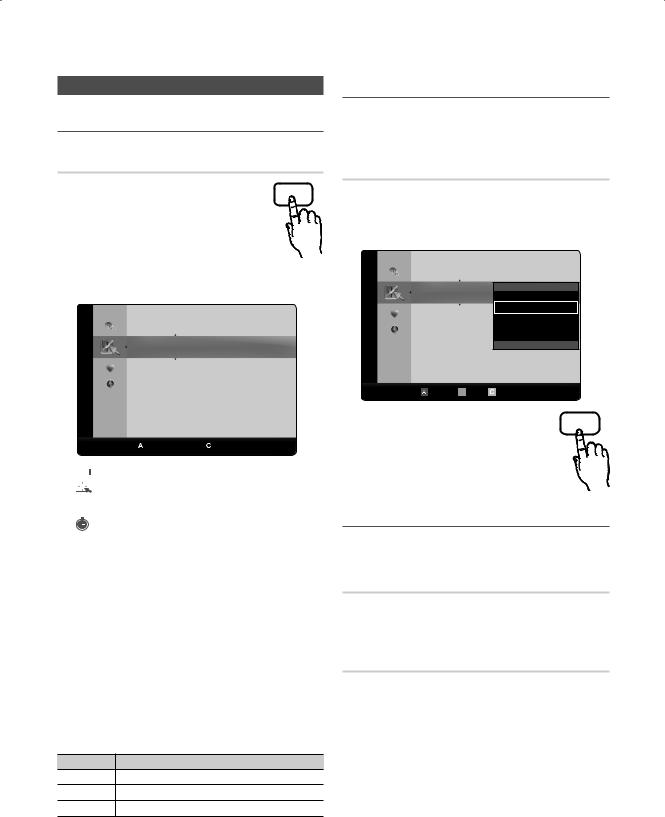
Basic Features
Channel Menu
¦¦ Seeing Channels
Channel List
Add, delete or set Favorite channels and use |
CH LIST |
the program guide for digital broadcasts. |
OO MENUm→ Channel → Channel List → ENTERE
Select a channel in the All Channels, Added Channels, Favorite or Programmed screen by pressing the ▲ / ▼ and ENTEREbuttons. Then you can watch the selected channel.
|
6 |
|
|
Air |
||||
Added |
6-1 |
* TV #6 |
||||||
7 |
|
|
Air |
|||||
Channels |
8 |
|
|
Air |
||||
10 |
|
|
Air |
|||||
|
9 |
|
|
Air |
||||
|
9-1 |
* TV #9 |
||||||
|
10-1 |
* TV #10 |
||||||
|
11-1 |
* TV #11 |
||||||
Air |
|
|
Antenna |
|
|
Zoom |
|
Select kPage TTools |
|
|
B |
|
|||||
|
|
|
|
|
|
|
|
|
■■  All Channels: Shows all currently available channels. ■■
All Channels: Shows all currently available channels. ■■ 

 Added Channels: Shows all added channels.
Added Channels: Shows all added channels.
■■ *Favorite: Shows all favorite channels.
■■ Programmed: Shows all currently reserved programs.
Using the color buttons with the Channel List.
 Red (Antenna): Switches to Air or Cable.
Red (Antenna): Switches to Air or Cable.
 Green (Zoom): Enlarges or shrinks a channel number.
Green (Zoom): Enlarges or shrinks a channel number.
xx Yellow (Select): Selects multiple channel lists. Select desired channels and press the Yellow button to set all the selected channels at the same time. The cmark appears to the left of the selected channels.
Yellow (Select): Selects multiple channel lists. Select desired channels and press the Yellow button to set all the selected channels at the same time. The cmark appears to the left of the selected channels.
xx k(Page): Move to next or previous page.
xx T(Tools): Displays the Channel List option menu. (The Options menus may differ depending on the situation.)
Channel Status Display Icons
Icons Operations
c A channel selected.
*A channel set as a Favorite.
) A reserved Program.
¦¦ Using Favorite Channels
OO MENUm→ Channel → Channel List → ENTERE
Add to Favorite / Delete from Favorite t
Set channels you watch frequently as Favorites.
1.Select a channel and press the TOOLS button.
2.Add or delete a channel using the Add to Favorite or
Delete from Favorite menu respectively.
|
6 |
Air |
|
|
Added |
6-1 |
* TV #6 |
|
|
7 |
Air |
Delete |
|
|
|
|
|||
Channels |
8 |
Air |
Add to Favorite |
|
10 |
Air |
Timer Viewing |
|
|
|
9 |
Air |
Channel Name Edit |
|
|
9-1 |
* TV #9 |
Select All |
|
|
10-1 |
* TV #10 |
|
|
|
11-1 |
* TV #11 |
|
|
Air |
Antenna |
B Zoom |
Select kPage TTools |
|
To show all Favorite channels, click on the |
FAV.CH |
|||
button shown on the right. |
|
|||
¦¦ Memorizing Channels
OO MENUm→ Channel → ENTERE
Antenna (Air / Cable) t
Before your television can begin memorizing the available channels, you must specify the type of signal source that is connected to the TV (i.e. an Air or a Cable system).
Auto Program
■■ Air: Air antenna signal.
■■ Cable: Cable antenna signal. ■■ Auto: Air and Cable antenna.
14 English

NOTE
xx When selecting the Cable TV system: STD, HRC and IRC identify various types of cable TV systems. Contact your local cable company to identify the type of cable system that exists in your particular area. At this point, the signal source has been selected.
xx After all the available channels are stored, it starts to remove scrambled channels. The Auto Program menu then reappears.
¦¦ Editing Channels
OO MENUm→ Channel → Channel List → ENTERE
Channel Name Edit
1.Select a channel and press the TOOLS button.
2.Edit the channel name using the Channel Name Edit menu.
■■ Channel Name Edit (analog channels only): Assign your own channel name.
¦¦ Other Features
OO MENUm→ Channel → ENTERE
Clear Scrambled Channel
This function is used to filter out scrambled channels after Auto Program is completed. This process may take up to 20~30 minutes.
How to Stop Searching Scrambled Channels
1.Press the ENTEREbutton to select Stop.
2.Press the ◄ button to select Yes.
3.Press the ENTEREbutton.
This function is only available in Cable mode.
Channel List
Channel List Option Menu
Set each channel using the Channel List menu options (Add / Delete, Timer Viewing, Select All / Deselect All). Option menu items may differ depending on the channel status.
1.Select a channel and press the TOOLS button.
2.Select a function and change its settings.
■■ Add / Delete: Delete or add a channel to display the channels you want.
NOTE
xx All deleted channels will be shown on the All Channels menu.
xx A gray-colored channel indicates the channel has been deleted.
xx The Add menu only appears for deleted channels.
xx Delete a channel from the Added Channels or Favorite menu in the same manner.
■■ Timer Viewing: You can set a desired channel to be displayed automatically at the reserved time. Set the current time first to use this function.
1.Press the ◄ / ► / ▲ / ▼ buttons to select the desired channel in Channel List.
2.Press the TOOLS button, then select Timer Viewing.
3.Scroll up or down to adjust the settings in the box, or use the numeric buttons on your remote to enter the date and time.
If you selected Once, Every Week or Everyday
in Repeat, you can enter the date you want.
4.Select OK, then press the ENTEREbutton when done.
NOTE
xx Only memorized channels can be reserved.
xx Reserved programs will be displayed in the
Programmed menu.
xx When a digital channel is selected, press the ► button to view the digital program.
■■ Select All: Select all the channels in the channel list. ■■ Deselect All: Deselect all the selected channels.
You can only select Deselect All when one or more channels are selected.
 Programmed
Programmed
(in Channel List)
You can view, modify or delete a show you have reserved to watch. Programmed timer viewing is displayed here. Highlight a program and press the TOOLS button to display Options.
■■ Change Info: Change a show you have reserved to watch. Begin with step 3 of “Timer Viewing,” above.
■■ Cancel Schedules: Cancel a show you have reserved to watch.
This deletes the highlighted or selected program(s).
Features Basic 03
English 15

Basic Features
■■ Information: Display a show you have reserved to watch. (You can also change the reservation Information.)
Alternatively, you can view Information by highlighting a program and pressing the ENTEREbutton.
■■ Select All / Deselect All: Select or deselect all reserved programs.
Fine Tune
(analog channels only)
If the reception is clear, you do not have to fine tune the channel, as this is done automatically during the search and store operation. If the signal is weak or distorted, fine tune the channel manually. Scroll to the left or right until the image is clear.
Settings are applied to the channel you're currently watching.
Fine tuned channels that have been saved are marked with an asterisk “*” on the right-hand side of the channel number in the channel banner.
To reset the fine-tuning, select Reset.
Picture Menu
¦¦ Changing the Preset Picture Mode
OO MENUm→ Picture → Mode → ENTERE
Mode |
|
|
Select your preferred picture type. |
P.MODE |
|
■■ Dynamic: Suitable for a bright room. |
||
|
||
■■ Standard: Suitable for a normal |
|
|
environment. |
|
■■ Natural: Suitable for reducing eye strain.Natural is not available in PC mode.
■■ Movie: Suitable for watching movies in a dark room.
¦¦ Adjusting Picture Settings
OO MENUm→ Picture → ENTERE
Backlight / Contrast / Brightness / Sharpness / Color / Tint (G/R)
Your television has several setting options for picture quality control.
NOTE
xx When you make changes to Backlight, Contrast, Brightness, Sharpness, Color or Tint (G/R) the OSD will be adjusted accordingly.
xx In PC mode, you can only make changes to
Backlight, Contrast and Brightness.
xx Settings can be adjusted and stored for each external device connected to the TV.
¦¦ Economical Solutions
The Eco Function can be used to enhance your power savings.
Eco Solution
OO MENUm→ Picture → Eco Solution → ENTERE
■■ Energy Saving (Off / Low / Medium / High / Picture Off / Auto): This adjusts the brightness of the TV in order to reduce power consumption. If you select Picture Off, the screen is turned off, but the sound remains on. Press any button except the volume button to turn on the screen.
■■ Eco Sensor (Off / On): To enhance your power savings; the picture settings will automatically adapt to the light in the room.
If you adjust the Backlight, the Eco Sensor will be set to Off.
Min Backlight: When Eco sensor is On, the minimum screen brightness can be adjusted manually.
If Eco Sensor is On, the display brightness may change (become slightly darker in most cases) depending on the surrounding light intensity.
■■ No Signal Power Off (Off / 15 min / 30 min / 60 min): To avoid unnecessary energy consumption, set how long you want the TV to remain on if it's not receiving a signal.
Disabled when the PC is in power saving mode.
16 English
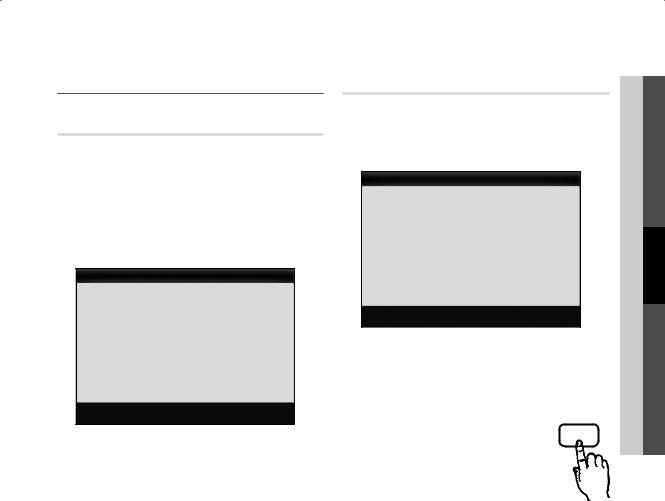
¦¦ Changing the Picture Options
Advanced Settings
OO MENUm→ Picture → Advanced Settings → ENTERE
(Advanced Settings are available in Standard / Movie mode)
Compared to previous models, new Samsung TVs have a more precise picture.
In PC mode, you can only make changes to Dynamic Contrast, Gamma, White Balance and LED Motion Plus.
Advanced Settings
Black Tone |
: Off |
► |
Dynamic Contrast |
: Medium |
|
Shadow Detail |
: -2 |
|
Gamma |
: 0 |
|
RGB Only Mode |
: Off |
|
Color Space |
: Native |
|
White Balance |
|
|
|
▼ |
|
|
UMove EEnter |
RReturn |
■■ Black Tone (Off / Dark / Darker / Darkest): Select the black level to adjust the screen depth.
■■ Dynamic Contrast (Off / Low / Medium / High): Adjust the screen contrast.
■■ Shadow Detail (-2~+2): Increase the brightness of dark images.
■■ Gamma: Adjust the primary color intensity.
■■ RGB Only Mode (Off / Red / Green / Blue): Displays the Red, Green and Blue color for making fine adjustments to the hue and saturation.
■■ Color Space (Auto / Native / Custom): Adjust the range of colors available to create the image. To adjust
Color, Red, Green, Blue and Reset, set Color Space to Custom.
■■ White Balance: Adjust the color temperature for a more natural picture.
R-Offset / G-Offset / B-Offset: Adjust each color's (red, green, blue) darkness.
R-Gain / G-Gain / B-Gain: Adjust each color's (red, green, blue) brightness.
Reset: Resets the White Balance to it's default settings.
■■ Flesh Tone: Emphasize pink “Flesh Tone.”
■■ Edge Enhancement (Off / On): Emphasize object boundaries.
■■ LED Motion Plus (Off / On): Removes drag from fast scenes with a lot of movement to provide a clear picture.
Picture Options
OO MENUm→ Picture → Picture Options → ENTERE
In PC mode, you can only make changes to the Color Tone, Size and Auto Protection Time.
Picture Options
Color Tone |
: Normal |
► |
Size |
: 16:9 |
|
Digital Noise Filter |
: Auto |
|
MPEG Noise Filter |
:Auto |
|
HDMI Black Level |
: Normal |
|
Film Mode |
: Off |
|
Auto Protection Time |
: 2 hours |
|
|
UMove EEnter |
RReturn |
■■ Color Tone (Cool / Normal / Warm1 / Warm2)
Warm1 or Warm2 will be deactivated when the picture mode is Dynamic.
Settings can be adjusted and stored for each external device connected to an input on the TV.
■■ Size: Your cable box/satellite receiver may
have its own set of screen sizes as well. P.SIZE However, we highly recommend you use
16:9 mode most of the time. 16:9: Sets the picture to 16:9 wide mode.
Zoom1: Use for moderate magnification. Zoom2: Use for a stronger magnification.
Wide Fit: Enlarges the aspect ratio of the picture to fit the entire screen.
Available with HD 1080i / 720p signals in 16:9 mode.
4:3: Sets the picture to basic (4:3) mode.
Do not watch in 4:3 format for a long time. Traces of borders displayed on the left, right and center of the screen may cause image retention(screen burn) which are not covered by the warranty.
Screen Fit: Displays the full image without any cut-off when HDMI (720p / 1080i / 1080p) or Component (1080i / 1080p) signals are inputted.
NOTE
xx After selecting Zoom1, Zoom2 or Wide Fit:
1.Press the ► button to select Position.
2.Press the ENTEREbutton.
3.Press the ▲ or ▼ button to move the picture up or down.
4.Press the ENTEREbutton.
5.Press the ► button to select Reset.
6.Press the ENTEREbutton to reset the picture to its default position.
English 17
Features Basic 03

Basic Features
xx After selecting Screen Fit in HDMI (1080i/1080p) or Component (1080i/1080p) mode, you may need to center the picture:
1.Press the ◄ or ► button to select Position.
2.Press the ENTEREbutton.
3.Press the ▲, ▼, ◄ or ► button to move the picture.
4.Press the ENTEREbutton.
5.Press the ◄ or ► button to select Reset.
6.Press the ENTEREbutton.
xx HD (High Definition): 16:9 - 1080i/1080p (1920x1080), 720p (1280x720)
xx Settings can be adjusted and stored for each external device you have connected to an input on the TV.
Input Source |
Picture Size |
ATV, AV, |
16:9, Zoom1, |
Component (480i, 480p) |
Zoom2, 4:3 |
DTV(1080i), |
16:9, 4:3, Wide Fit, |
Component (1080i, 1080p), |
Screen Fit |
HDMI (720p, 1080i, 1080p) |
|
PC |
16:9, 4:3 |
■■ Digital Noise Filter (Off / Low / Medium / High / Auto / Auto Visualization): If the broadcast signal received by your TV is weak, you can activate the Digital Noise Filter feature to reduce any static and ghosting that may appear on the screen.
When the signal is weak, try other options until the best picture is displayed.
Auto Visualization: When changing analog channels, displays signal strength.
Only available for analog channels.
When bar is green, you are receiving the best possible signal.
■■ MPEG Noise Filter (Off / Low / Medium / High / Auto): Reduces MPEG noise to provide improved picture quality.
■■ HDMI Black Level (Normal / Low): Selects the black level on the screen to adjust the screen depth.
Available only in HDMI mode.
■■ Film Mode (Off / Auto1 / Auto2): Sets the TV to automatically sense and process film signals from all sources and adjusts the picture for optimum quality.
Available in TV, AV, COMPONENT (480i / 1080i) and HDMI (480i / 1080i).
■■ Auto Protection Time (2 hours / 4 hours / 8 hours / 10 hours / Off): Set the time the screen remains idle
with a still image until the screen saver is activated. The screen saver prevents the formation of ghost images on the screen.
Picture Reset (OK / Cancel)
Resets your current picture mode to its default settings.
¦¦ Setting up the TV with Your PC
Set the input source to PC.
OO MENUm→ Picture → ENTERE
Auto Adjustment t
Adjust frequency values/positions and fine tune the settings automatically.
Not available when connecting with an HDMI/DVI cable.
Screen
■■ Coarse / Fine: Removes or reduces picture noise. If the noise is not removed by Fine-tuning alone, then adjust the frequency as best as possible (Coarse) and Finetune again. After the noise has been reduced, readjust the picture so that it is aligned to the center of screen.
■■ Position: Adjust the PC’s screen positioning if it does not fit the TV screen. Press the ▲ or ▼ button to adjust the Vertical-Position. Press the ◄ or ► button to adjust the Horizontal-Position.
■■ Image Reset: Resets the image to default settings.
Using Your TV as a Computer (PC) Display
Setting Up Your PC Software (Based on Windows XP)
Depending on the version of Windows and the video card, the actual screens on your PC will probably look different, but the same basic set-up information will apply in most cases. (If not, contact your computer manufacturer or Samsung Dealer.)
1.Click on “Control Panel” on the Windows start menu.
2.Click on “Appearance and Themes” in the “Control Panel” window and a display dialog-box will appear.
3.Click on “Display” and a display dialog box will appear.
4.Navigate to the “Settings” tab on the display dialog-box.
yy The correct size setting (resolution) [Optimum: 1920 X 1080 pixels]
yy If a vertical-frequency option exists on your display settings dialog box, the correct value is ‘60’ or ‘60 Hz’. Otherwise, just click ‘OK’ and exit the dialog box.
18 English

Sound Menu
¦¦ Changing the Preset Sound Mode
OO MENUm→ Sound → Mode → ENTERE
Mode |
|
|
■■ Standard: Selects the normal sound |
S.MODE |
|
mode. |
||
|
■■ Music: Emphasizes music over voices.
■■ Movie: Provides the best sound for movies.
■■ Clear Voice: Emphasizes voices over other sounds.
■■ Amplify: Increase the intensity of high-frequency sound to allow a better listening experience for the hearing impaired.
¦¦ Adjusting Sound Settings
OO MENUm→ Sound → ENTERE
Equalizer
Adjusts the sound mode (standard sound mode only).
■■ Balance L/R: Adjusts the balance between the right and left speaker.
■■ 100Hz / 300Hz / 1kHz / 3kHz / 10kHz (Bandwidth Adjustment): Adjusts the level of specific bandwidth frequencies.
■■ Reset: Resets the equalizer to its default settings.
¦¦ Sound Settings
OO MENUm→ Sound → ENTERE
Virtual Surround (Off / On)
(standard sound mode only)
This function provides a virtual 5.1 channel surround sound experience through a pair of speakers using HRTF (Head Related Transfer Function) technology.
Preferred Language |
|
|
(digital channels only) |
MTS |
|
Digital-TV broadcasts are capable of |
||
|
||
simultaneous transmission of many audio tracks |
|
|
(for example, simultaneous translations of the |
|
|
program into foreign languages). |
|
|
You can only select a language among the |
|
|
ones being broadcasted. |
|
|
Multi-Track Sound (MTS) t |
|
|
(analog channels only) |
MTS |
|
■■ Mono: Choose for channels that are |
||
|
||
broadcasting in mono or if you are having |
|
|
difficulty receiving a stereo signal. |
|
■■ Stereo: Choose for channels that are broadcasting in stereo.
■■ SAP: Choose to listen to the Separate Audio Program, which is usually a foreign-language translation.
Depending on the particular program being broadcast, you can listen to Mono, Stereo or SAP.
Auto Volume (Off / Normal / Night)
To equalize the volume level on each channel, set to Normal.
■■ Night: This mode provides an improved sound experience compared to Normal mode, making almost no noise. It is useful at night.
Speaker Select (External Speaker / TV
Speaker)
A sound echo may occur due to a difference in decoding speed between the main speaker and the audio receiver. In this case, set the TV to External Speaker.
When Speaker Select is set to External Speaker, the volume and MUTE buttons will not operate and the sound settings will be limited.
When Speaker Select is set to External Speaker.
When Speaker Select is set to TV Speaker.
If there is no video signal, both speakers will be mute.
Features Basic 03
Dialog Clarity (Off / On)
(standard sound mode only)
This function allows you to increase the intensity of a voice over background music or sound effects so that dialog can be heard more clearly.
English 19

Basic Features
SPDIF Output
SPDIF (Sony Philips Digital Interface) is used to provide digital sound, reducing interference going to speakers and various digital devices such as an A/V Receiver/Home theater.
■■ Audio Format: During the reception of a digital TV broadcast, you can select the Digital Audio output (SPDIF) format from the options PCM or Dolby Digital.
■■ Audio Delay: Correct audio-video sync problems, when watching TV or video, and when listening to digital audio output using an external device such as an AV receiver (0ms ~ 250ms).
Sound Reset (OK / Cancel)
Reset all sound settings to the factory defaults.
Setup Menu
¦¦ Setting the Time
OO MENUm→ Setup → Time → ENTERE
Time
■■ Clock: Setting the clock is for using various timer features of the TV.
OO The current time will appear every time you press the INFO button.
If you disconnect the power cord, you have to set the clock again.
Clock Mode (Auto / Manual)
–– Auto: Set the current time automatically using the time from a digital channel.
The antenna must be connected in order to set the time automatically.
––Manual: Set the current time manually.
Depending on the broadcast station and signal, the auto time set up may not be correct. In this case, set the time manually.
Clock Set: Set the Month, Day, Year, Hour, Minute and am/pm manually.
Available only when Clock Mode is set to
Manual.
You can set the Month, Day, Year, Hour and Minute directly by pressing the number buttons on the remote control.
Time Zone: Select your time zone.
This function is only available when the Clock Mode is set to Auto.
DST (Daylight Saving Time) (Off / On): Switches the Daylight Saving Time function on or off.
This function is only available when the Clock Mode is set to Auto.
20 English
¦¦ Using the Sleep Timer
OO MENUm→ Setup → Time → Sleep Timer →
ENTERE
■■ Sleep Timer: Automatically shuts off the TV |
SLEEP |
after a preset period of time. (30, 60, 90, |
|
120, 150 and 180 minutes). |
|
To cancel the Sleep Timer, select |
|
Off. |
|
¦¦ Setting the On / Off Timer
OO MENUm→ Setup → Time → Timer 1 → ENTERE
You can set the TV to turn on automatically at a preset time.
■■ Timer 1 / Timer 2 / Timer 3: Three different on / off timer settings can be made. You must set the clock first.
Timer 1
On Time
▲ |
|
|
|
00 |
|
|
|
|
00 |
|
|
|
am |
|
|
||
Inactivate |
|
|
|
|
|
|
|
|
|
|
|
|
|||||
▼ |
|
|
|
|
|
|
|
|
|
|
|
|
|
|
|
|
|
Off Time |
|
|
|
|
|
|
|
|
|
|
|
|
|
|
|
|
|
Inactivate |
|
|
|
00 |
|
|
|
|
00 |
|
|
|
am |
|
|
||
Volume |
|
Source |
|
|
|
|
Antenna |
|
|
Channel |
|
|
|||||
20 |
|
|
|
TV |
|
|
Air |
|
|
|
1 |
|
|
||||
|
|
|
|
|
|
|
|
|
|
|
|
|
|
|
|
|
|
Repeat |
|
|
Sun |
Mon |
|
Tue |
Wed |
|
Thu |
Fri |
Sat |
||||||
Once |
|
|
|
|
|
|
|
|
|
|
|
|
|
|
|
|
|
|
|
|
LMove |
UAdjust |
EEnter |
RReturn |
|||||||||||
On Time / Off Time: Set the hour, minute, and activate / inactivate. (To activate the timer with the setting you’ve chosen, set to Activate.)
Volume: Set the desired volume level.
Source: Select TV or USB content to be played when the TV is turned on automatically. (USB can be selected only when a USB device is connected to the TV)
Antenna (when the Source is set to TV): Select Air or
Cable.
Channel (when the Source is set to TV): Select the desired channel.

Contents (when the Source is set to USB): Select a folder in the USB device containing music or photo files
to be played when the TV is turned on automatically.
NOTE
xx If there is no music file on the USB device or the folder containing a music file is not selected, the Timer function does not operate correctly.
xx When there is only one photo file in the USB, the Slide Show will not play.
xx If a folder name is too long, the folder cannot be selected.
xx Each USB you use is assigned its own folder. When using more than one of the same type of USB, make sure the folders assigned to each USB have different names.
Repeat: Select Once, Everyday, Mon~Fri, Mon~Sat, Sat~Sun or Manual to set at you convenience. If you select Manual, you can set up the day you want to activate the timer.
The cmark indicates the day is selected.
Auto Power Off (available only when the TV is turned on by the Timer): The TV will be automatically turned off after 3 hours of being left idle to prevent overheating.
¦¦ Locking Programs
OO MENUm→ Setup → Security → ENTERE
Security
The PIN input screen appears, Enter your 4 digit PIN number.
■■ V-Chip: The V-Chip feature automatically locks out programs that are deemed inappropriate for children. The user must enter a PIN (personal identification number) before any of the V-Chip restrictions are set up or changed.
NOTE
xx V-Chip is not available in HDMI, Component or PC mode.
xx The default PIN number of a new TV set is “0-0-0-0”.
xx Allow All: Press to unlock all TV ratings. xx Block All: Press to lock all TV ratings.
V-Chip Lock (Off / On): You can block rated TV Programs.
TV Parental Guidelines: You can block TV programs depending on their rating. This function allows you to control what your children are watching.
––TV-Y: Young children / TV-Y7: Children 7 and over / TV-G: General audience / TV-PG: Parental guidance
/TV-14: Viewers 14 and over / TV-MA: Mature audience
––ALL: Lock all TV ratings. / FV: Fantasy violence / V: Violence / S: Sexual situation / L: Adult Language / D: Sexually Suggestive Dialog
The V-Chip will automatically block certain
categories dealing with more sensitive material. For example, if you block the TV-Y category, then TV-Y7 will automatically be blocked. Similarly, if you block the TV-G category, then all the categories in the young adult group will be blocked (TV-G, TV-PG, TV-14 and TV-MA). The sub-ratings (D, L, S, V) work similarly. So, if you block the L sub-rating in TV-PG, then the L sub-ratings in TV-14 and TV-MA will automatically be blocked.
MPAA Rating: You can block movies depending on their MPAA rating. The Motion Picture Association of America(MPAA) has implemented a rating system that provides parents or guardians with advanced information on which films are appropriate for children.
––G: General audience (no restrictions). / PG: Parental guidance suggested. / PG-13: Parents strongly cautioned. / R: Restricted. Children under 17 should be accompanied by an adult. / NC-17: No children under age 17. / X: Adults only. / NR: Not rated.
The V-Chip will automatically block any
category that deals with more sensitive material. For example, if you block the PG-13 category, then R, NC-17 and X will automatically be blocked.
Canadian English: You can block TV programs depending on their Anglophone Canadian ratings.
––C: Programming intended for children under age 8. / C8+: Programming generally considered acceptable for children 8 years and over to watch on their own.
/G: General programming, suitable for all audiences.
/PG: Parental Guidance. / 14+: Programming contains themes or content which may not be suitable for viewers under the age of 14. / 18+: Adult programming.
The V-Chip will automatically block any
category that deals with more sensitive material. For example, if you block the G category, then PG, 14+ and 18+ will automatically be blocked.
Features Basic 03
English 21

Basic Features
Canadian French: You can block TV programs depending on their French Canadian rating.
––G: General / 8 ans+: Programming generally considered acceptable for children 8 years and over to watch on their own. / 13 ans+: Programming may not be suitable for children under the age of 13. / 16 ans+: Programming is not suitable for children under the age of 16. / 18 ans+: Programming restricted to adults.
The V-Chip will automatically block any
category that deals with more sensitive material. For example, if you block the 8 ans+ category, then 13 ans+, 16 ans+ and 18 ans+ will automatically be blocked also.
Downloadable U.S. Rating: Parental restriction
information can be used while watching DTV channels.
NOTE
xx If information is not downloaded from the broadcasting station, the Downloadable U.S. Rating menu is deactivated.
xx Parental restriction information is automatically downloaded while watching DTV channels. It may take several seconds.
xx The Downloadable U.S. Rating menu is available for use after information is
downloaded from the broadcasting station. However, depending on the information from the broadcasting station, it may not be available for use.
xx Parental restriction levels differ depending on the broadcasting station. The default menu name and Downloadable US Rating change depending on the downloaded information.
xx Even if you set the on-screen display to another language, the Downloadable U.S. Rating menu will appear in English only.
xx The rating will automatically block certain categories that deal with more sensitive material.
xx The rating titles (For example: Humor Level..etc) and TV ratings (For example: DH, MH, H..etc) may differ depending on the broadcasting station.
■■ Change PIN: The Change PIN screen will appear. Choose any 4 digits for your PIN and enter them. As soon as the 4 digits are entered, the Confirm New PIN screen appears. Re-enter the same 4 digits. When the Confirm screen disappears, your PIN has been memorized.
How to watch a restricted channel
If the TV is tuned to a restricted channel, the V-Chip will block it. The screen will go blank and the following message will appear:
This channel is blocked by V-Chip. Please enter the PIN to unblock.
If you forget the PIN, press the remote-control buttons in the following sequence, which resets the pin to ‘0-0- 0-0:’ POWER (off) → MUTE → 8 → 2 → 4 → POWER
(on)
¦¦ Other Features
OO MENUm→ Setup → ENTERE
Menu Language
Set the menu language.
1.Select Menu Language and press the ENTERE button.
2.Choose desired language and press the ENTERE button.
Choose between English, Español and Français.
Caption
(On-Screen Text Messages) |
|
■■ Caption (Off / On): You can switch the |
CC |
caption function on or off. If captions are |
|
not available, they will not be displayed on |
|
the screen. |
|
The Caption feature doesn’t work in |
|
Component, HDMI or PC modes. |
|
■■ Caption Mode: You can select the desired caption mode.
The availability of captions depends on the program being broadcast.
Default / CC1~CC4 / Text1~Text4: (analog channels only) The Analog Caption function operates in either analog TV channel mode or when a signal is supplied from an external device to the TV. (Depending on the broadcasting signal, the Analog Caption function may or may not work with digital channels.)
Default / Service1~Service6 / CC1~CC4 / Text1~Text4: (digital channels only) The Digital Captions function works with digital channels.
Service1~6 may not be available in digital caption mode depending on the broadcast.
22 English

■■ Digital Caption Options: (digital channels only)
Size: Options include Default, Small, Standard and Large. The default is Standard.
Font Style: Options include Default and Styles 0 to 7. The default is Style 0.
Foreground Color: Options include Default, White, Black, Red, Green, Blue, Yellow, Magenta and Cyan. You can change the color of the letter. The default is White.
Background Color: Options include Default, White, Black, Red, Green, Blue, Yellow, Magenta and Cyan. You can change the background color of the caption. The default is Black.
Foreground Opacity: This adjusts the opacity of text. Options include Default, Transparent, Translucent, Solid and Flashing.
Background Opacity: This adjusts the opacity of the caption background. Options include Default, Transparent, Translucent, Solid and Flashing.
Return to Default: This option sets each Size, Font Style, Foreground Color, Background Color, Foreground
Opacity and Background Opacity to its default.
NOTE
xx Digital Caption Options are available only when Default and Service1 ~ Service6 can be selected in Caption Mode.
xx The availability of captions depends on the program being broadcasted.
xx The Default setting follows the standards set by the broadcaster.
xx The Foreground and Background cannot be set to have the same color.
xx You cannot set both the Foreground Opacity and the Background Opacity to Transparent.
Network (Network Type / Network Setup
/ Network Test )
For details on set up options, refer to the “Network Connection” instructions (p. 25).
General
■■ Game Mode (Off / On): When connecting to a game console such as PlayStation™ or Xbox™, you can enjoy a more realistic gaming experience by selecting the game mode.
NOTE
xx Precautions and limitations for game mode
––To disconnect the game console and connect another external device, set Game Mode to Off in the setup menu.
––If you display the TV menu in Game Mode, the screen shakes slightly.
xx Game Mode is not available when the input source is set to TV or PC.
xx After connecting the game console, set Game Mode to On. Unfortunately, you may notice reduced picture quality.
xx If Game Mode is On:
––Picture mode is set to Standard and Sound mode is set to Movie.
––Equalizer is not available.
■■ Menu Transparency (Bright / Dark): Set the Transparency of the menu.
■■ Melody (Off / Low / Medium / High): Set so that a melody plays when the TV is turned on or off.
¦¦ Picture In Picture (PIP)
PIP t
You can watch the TV tuner and one external video source simultaneously. PIP (Picture-in-Picture) does not function in the same mode.
OO MENUm→ Setup → PIP → ENTERE
NOTE
xx For PIP sound, refer to the Sound Select instructions.
xx If you turn the TV off while watching in PIP mode, the PIP window will disappear.
xx You may notice that the picture in the PIP window becomes slightly unnatural when you use the main screen to view a game or karaoke.
xx While V-Chip is in operation, the PIP function cannot be used.
xx PIP Settings
Main picture |
Sub picture |
Component, HDMI1/DVI, |
|
HDMI2, HDMI3, HDMI4, |
TV |
PC |
|
■■ PIP (Off / On): Activate or deactivate the PIP function.
■■ Air/Cable (Air / Cable): Select either Air or Cable as the input source for the sub-screen.
■■ Channel: Select the channel for the sub-screen. ■■ Size (Õ/ Ã): Select a size for the sub-picture.
■■ Position (Ã/ –/ —/ œ): Select a position for the sub-picture.
■■ Sound Select (Main / Sub): You can choose the desired sound (Main / Sub) in PIP mode.
English 23
Features Basic 03
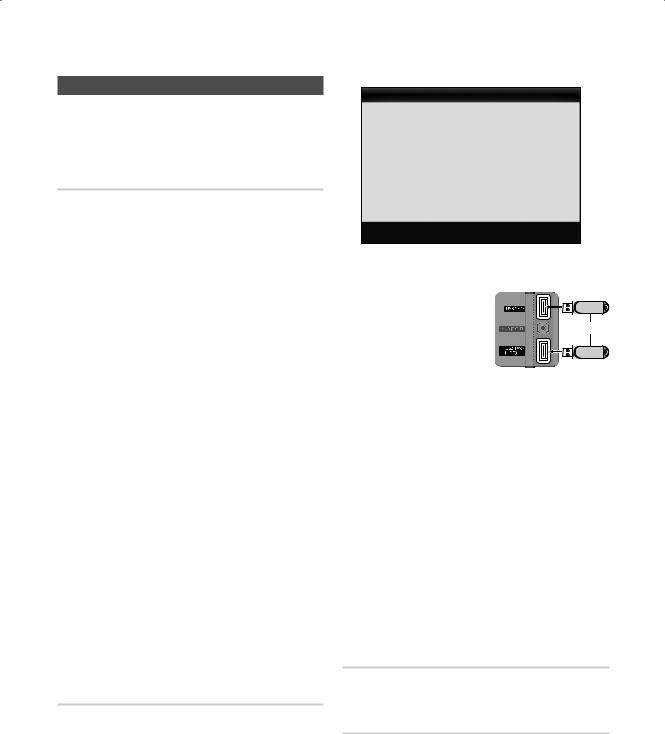
Basic Features
Support Menu
OO MENUm→ Setup → Support → ENTERE
Self Diagnostic might take few seconds, this is part of the normal operation of the TV.
Self Diagnosis
■■ Picture Test: Use to check for picture problems.
Yes: If the test pattern does not appear or there is noise in the test pattern, select Yes. There may be a problem with the TV. Contact Samsung’s Call Center for assistance (1-800-SAMSUNG).
No: If the test pattern is properly displayed, select No. There may be a problem with your external equipment. Please check your connections. If the problem persists, refer to the external device’s user manual.
■■ Sound Test: Use the built-in melody sound to check for sound problems.
If you hear no sound from the TV’s speakers, before performing the sound test, make sure
Speaker Select is set to TV Speaker in the Sound menu.
The melody will be heard during the test even if
Speaker Select is set to External Speaker or the sound is muted by pressing the MUTE button.
Yes: If you can hear sound only from one speaker or not at all during the sound test, select Yes. There may be a problem with the TV. Contact Samsung’s Call Center for assistance (1-800-SAMSUNG).
No: If you can hear sound from the speakers, select No. There may be a problem with your external equipment. Please check your connections. If the problem persists, refer to the external device’s user manual.
■■ Signal Information: (Digital channels only) An HD channel’s reception quality is either perfect or the channels are unavailable. Adjust your antenna to increase signal strength.
■■ Troubleshooting: If the TV seems to have a problem, refer to this description.
If none of these troubleshooting tips apply, contact the Samsung customer service center.
Software Upgrade
Software Upgrade can be performed by network connection or downloading the latest firmware from “www. samsung.com,” to a USB memory device.
Current Version - the software already installed in the TV.Software is represented as ‘Year/Month/Day_Version’.
Software Upgrade
Current Version |
2010/01/18_000001 |
|
|
|
|
|
|
By USB |
► |
By Online |
|
Alternative Software |
----/--/--_------ |
|
UMove EEnter RReturn |
Installing the Latest Version
■■ By USB: Insert a USB drive containing the firmware
upgrade file, downloaded from “www.samsung.com,”
into the TV. Please be careful
not to disconnect the power or remove the USB drive until upgrades are complete.
The TV will be turned off and
on automatically after completing the firmware upgrade. When software is upgraded, video and audio settings you have made will return to their default settings. We advise you to to write down your settings so that you can easily reset them after the upgrade.
■■ By Online: Upgrade the software using the Internet.
First, configure your network. For detailed procedures on using the Network Setup, refer to the “Network Connection” instructions.
If the internet connection doesn’t operate properly, the connection may be broken. Please retry downloading. If the problem persists, download by USB and upgrade.
■■ Alternative Software (backup): Displays the software version downloaded through By Online. During the software upgrading, When the Upgrade will discontinue from last step, this function be activated.
HD Connection Guide
Refer to this information when connecting external devices to the TV.
Contact Samsung
View this information when your TV does not work properly or when you want to upgrade the software. You can find information regarding our call centers and how to download products and software.
24 English
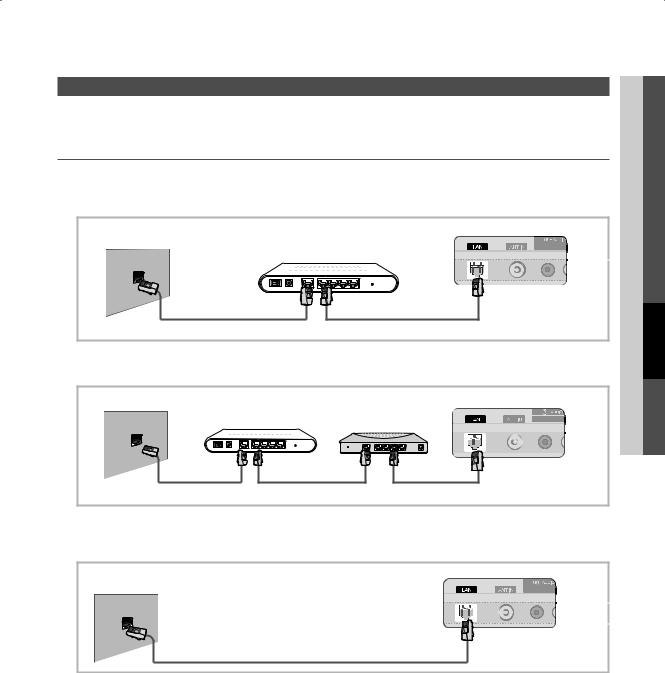
Advanced Features
Network Connection
You can set up your TV so that it can access the Internet through your local area network (LAN) using a wired or wireless connection.
¦¦ Connecting to a Wired Network
You can attach your TV to your LAN using cable in three ways:
yy You can attach your TV to your LAN by connecting the LAN port on the back of your TV to an external modem using a Cat 5 cable. See the diagram below.
|
TV Rear Panel |
The Modem Port on the Wall |
External Modem |
|
|
|
(ADSL / VDSL / Cable TV) |
Modem Cable |
LAN Cable |
yy You can attach your TV to your LAN by connecting the LAN port on the back of your TV to a IP Sharer which is connected to an external modem. Use a Cat 5 cable for the connection. See the diagram below.
The Modem Port on the Wall |
External Modem |
TV Rear Panel |
|
IP Sharer |
|||
|
|||
(ADSL / VDSL / Cable TV) |
|||
(having DHCP server) |
|||
|
|
||
Modem Cable |
LAN Cable |
LAN Cable |
|
yy Depending on how your network is configured, you may be able to attach your TV to your LAN by connecting the LAN port on the back of your TV directly to a network wall outlet using a Cat 5 cable. See the diagram below. Note that the wall outlet is attached to a modem or router elsewhere in your house.
TV Rear Panel |
The LAN Port on the Wall |
LAN Cable |
If you have a Dynamic Network, you should use an ADSL modem or router that supports Dynamic Host Configuration Protocol (DHCP). Modems and routers that support DHCP automatically provide the IP address, subnet mask, gateway, and DNS values your TV needs to access the Internet so you don’t have to enter them manually. Most home networks are Dynamic Networks.
Some networks require a Static IP address. If your network requires a Static IP address, you must enter the IP address, subnet mask, gateway, and DNS values manually on your TV’s Cable Setup Screen when you set up the network connection. To get the IP address, subnet mask, gateway, and DNS values, contact your Internet Service Provider (ISP). If you have a Windows computer, you can also get these values through your computer.
You can use ADSL modems that support DHCP if your network requires a Static IP address. ADSL modems that support DHCP also let you use Static IP addresses.
Features Advanced 04
English 25
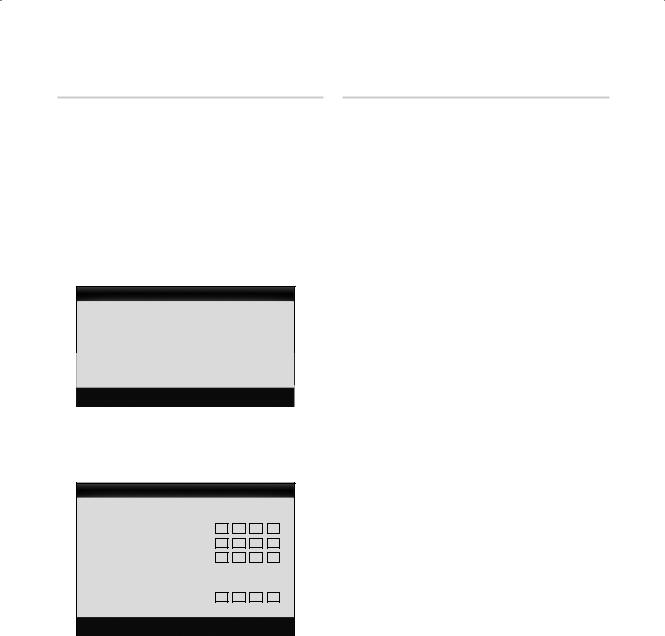
Advanced Features
Network Setup (Auto)
Use the Automatic Network Setup when connecting your TV to a network that supports DHCP. To set up your TV’s cable network connection automatically, follow these steps:
How to set up automatically
1.Connect your TV to your LAN as described in the previous section.
2.Turn on your TV, press the MENU button on your remote, use the ▲ or ▼ button to select Setup, and then press the ENTEREbutton.
3.Use the ▲ or ▼ button to select Network in the Setup menu, and then press the ENTEREbutton. The Network screen appears.
Network
Network Type |
: Wired |
► |
Network Setup |
|
|
Network Test |
|
|
|
UMove EEnter |
RReturn |
4.On the Network screen, select Network Type.
5.Set Network Type to Wired.
6.Select Network Setup. The Network Setup screen appears.
Network Setup
Internet Protocol Setup |
:Auto |
|
► |
||||||
IPAddress |
: |
|
|
|
|
|
|
|
|
|
|
|
|
|
|
|
|
||
|
|
|
|
|
|
|
|
||
Subnet Mask |
: |
|
|
|
|
|
|
|
|
|
|
|
|
|
|
|
|
||
|
|
|
|
|
|
|
|
||
Gateway |
: |
|
|
|
|
|
|
|
|
|
|
|
|
|
|
|
|
||
|
|
|
|
|
|
|
|
||
|
|
|
|
|
|||||
DNS |
: Auto |
|
|
|
|||||
DNS Server |
: |
|
|
|
|
|
|
|
|
|
|
|
|
|
|
|
|
||
|
|
|
|
|
|
|
|
||
|
UMove EEnter |
RReturn |
|||||||
7.Set Internet Protocol Setup to Auto.
8.Auto acquires and enters the needed Internet values automatically.
9.Wait two minutes, and then press the RETURN button on your remote.
10.If the Network Function has not acquired the network connection values, go to the directions for Manual.
Network Setup (Manual)
Use the Manual Network Setup when connecting your TV to a network that requires a Static IP address.
Getting the Network Connection Values
To get the Network connection values on most Windows computers, follow these steps:
1.Right click the Network icon on the bottom right of the screen.
2.In the pop-up menu that appears, click Status.
3.On the dialog that appears, click the Support tab.
4.On the Support Tab, click the Details button. The Network connection values are displayed.
How to set up manually
To set up your TV’s cable network connection manually, follow these steps:
1.Follow Steps 1 through 6 in the “How to set up automatically” procedure.
2.Set Internet Protocol Setup to Manual.
3.Press the ▼ button on your remote to go to the first entry field.
4.Enter the IP Address, Subnet Mask, Gateway, and
DNS Server values. Use the number buttons on your remote to enter numbers and the arrow buttons to move from one entry field to another.
5.When done, press the RETURN button on your remote.
6.Select Network Test to check the Internet connectivity.
26 English
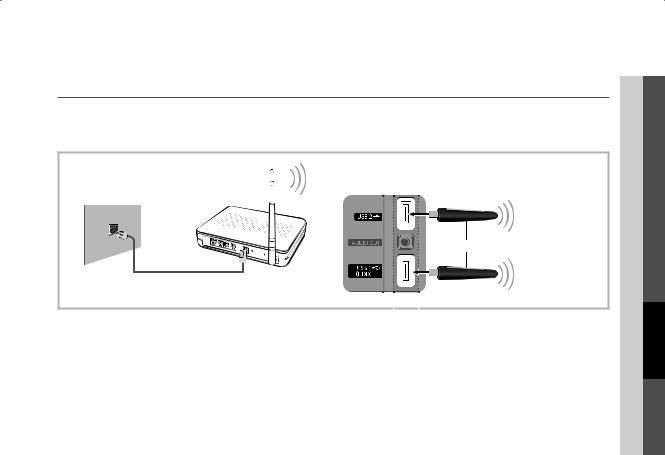
¦¦ Connecting to a Wireless Network |
|
|
04 |
|
To connect your TV to your network wirelessly, you need a wireless router or modem and a Samsung Wireless LAN Adapter |
Advanced |
|||
(WIS09ABGN, WIS09ABGN2, WIS10ABGN), which you connect to your TV’s back or side panel USB jack. See the illustration |
||||
below. |
|
|
|
|
|
|
|
|
|
The LAN Port on |
Wireless IP sharer |
TV Rear Panel |
|
Features |
the Wall |
(AP having DHCP Server) |
|
|
|
|
|
|
|
|
|
|
or |
Samsung Wireless |
|
|
|
LAN Adapter |
|
|
|
|
|
|
|
|
LAN Cable |
|
|
|
Samsung’s Wireless LAN adapter is sold separately and is offered by select retailers, Ecommerce sites and Samsungparts. com. Samsung’s Wireless LAN adapter supports the IEEE 802.11A/B/G and N communication protocols. Samsung recommends using IEEE 802.11N. When you play video over a IEEE 802.11B/G connection, the video may not play smoothly.
NOTE
xx You must use the “Samsung Wireless LAN Adapter” (WIS09ABGN, WIS09ABGN2, WIS10ABGN) to use a wireless network.
xx Samsung’s Wireless LAN Adapter is sold separately. The SAMSUNG Wireless LAN Adapter is offered by select retailers, Ecommerce sites and Samsungparts.com.
xx To use a wireless network, your TV must connect wirelessly to a wireless IP sharer (either a router or a modem). If the wireless IP sharer supports DHCP, your TV can use a DHCP or static IP address to connect to the wireless network.
xx Select a channel for the wireless IP sharer that is not currently being used. If the channel set for the wireless IP sharer is currently being used by another device nearby, this will result in interference and communication failure.
xx If you apply a security system other than the systems listed below, it will not work with the TV.
xx If you select the Pure High-throughput (Greenfield) 802.11N mode and set your AP's Security Encryption type to WEP, TKIP or TKIPAES (WPS2Mixed), your Samsung TV will not support the connection in compliance with new Wi-Fi certification specifications.
xx If your AP supports WPS (Wi-Fi Protected Setup), you can connect to the network via PBC (Push Button Configuration) or PIN (Personal Identification Number). WPS will automatically configure the SSID and WPA key in either mode.
xx If your router, modem, or device isn’t certified, it may not connect to the TV via the “Samsung Wireless LAN Adapter.” xx Connection Methods: You can setup the wireless network connection four ways.
––PBC (WPS)
––Auto Setup (Using the Auto Network Search function)
––Manual Setup
––Ad-Hoc
xx The Samsung Wireless LAN Adapter may not be recognized or work properly when connecting via a USB hub or via a USB extension cable other than the one available from Samsung.
English 27
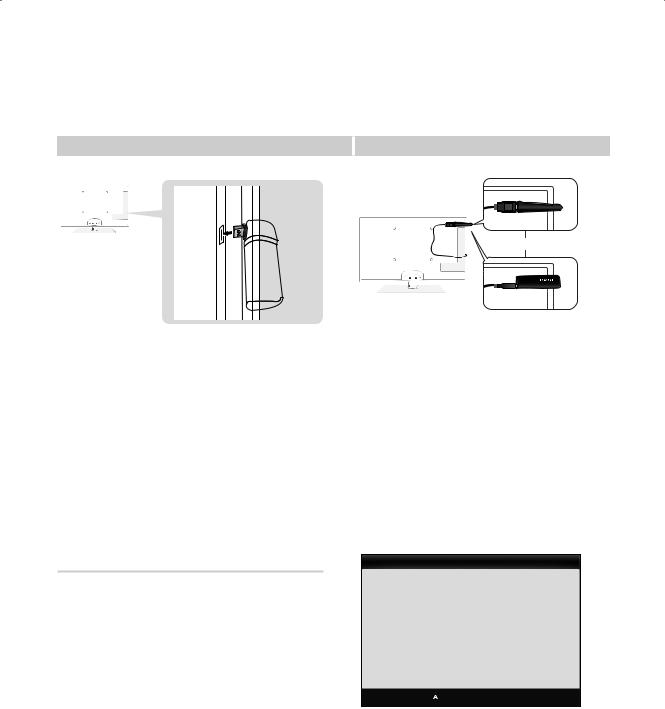
Advanced Features
Notice
The picture may appear corrupted or have static for some channels when the TV is connected to the Samsung Wireless LAN Adapter. In such a case, establish a connection using one of the following methods or connect the Samsung Wireless LAN Adapter using a USB cable in a place that is not affected by radio interference.
|
|
Method 1 |
Method 2 |
Connect using the USB right angle adapter |
Connect via an extension cable |
||
|
|
|
|
|
|
|
|
or
To connect the Samsung Wireless LAN Adapter using the USB right angle adapter, follow these steps:
1.Connect the USB right angle adapter to the Samsung Wireless LAN Adapter.
2.Connect the other end of the right angle adapter to the USB 1 (HDD) port.
Network Setup (PBC (WPS))
How to set up using PBC (WPS)
If your router has a PBC (WPS) button, follow these steps:
1.Connect your TV to Samsung Wireless LAN Adapter ad described in the previous section.
2.Turn on your TV, press the MENU button on your remote, use the ▲ or ▼ button to select Setup, and then press the ENTEREbutton.
3.Use the ▲ or ▼ button to select Network in the Setup menu, and then press the ENTEREbutton.
To reconnect the Samsung Wireless LAN Adapter using the extension cable, follow these steps:
The Samsung Wireless LAN Adapter should be installed in an interference-free area in order to avoid interference between the adapter and tuner.
1.Connect the extension cable to the USB 1 (HDD) port.
2.Connect the extension cable and Samsung Wireless LAN Adapter.
3.Attach the Samsung Wireless LAN Adapter to the back of the TV near the top, using double-sided adhesive tape.
Network Setup
Select a Network |
: Not Selected |
|
► |
||||||||
Internet Protocol Setup |
:Auto |
|
|
|
|||||||
IPAddress |
: |
|
|
|
|
|
|
|
|
||
|
|
|
|
|
|
|
|
||||
|
|
|
|
|
|
|
|
||||
Subnet Mask |
: |
|
|
|
|
|
|
|
|
||
|
|
|
|
|
|
|
|
||||
Gateway |
: |
|
|
|
|
|
|
|
|
||
|
|
|
|
|
|
|
|
||||
|
|
|
|
|
|
|
|
||||
|
|
|
|
|
|
|
|
|
|
|
|
DNS |
: Auto |
|
|
|
|||||||
DNS Server |
: |
|
|
|
|
|
|
|
|
||
|
|
|
|
|
|
|
|
||||
|
|
PBC(WPS) |
UMove EEnter |
RReturn |
|||||||
|
|
||||||||||
4.On the Network screen, select Network Type.
5.Set Network Type to Wireless.
6.Select Network Setup. The Network Setup screen appears.
28 English
7.Press the Red button on your remote.
8.Press the PBC (WPS) button on your router within 2 minutes. Your TV player automatically acquires all the network setting values it needs and connects to your network.
9.After the network connection is set up, press the RETURN button to exit the Network Setup screen.

Network Setup (Auto)
Most wireless networks have an optional security system that requires devices that access the network to transmit an encrypted security code called an Access or Security Key. The Security Key is based on a Pass Phrase, typically a word or a series of letters and numbers of a specified length you were asked to enter when you set up security for your wireless network. If you use this method of setting up the network connection, and have a Security Key for your wireless network, you will have to enter the Pass Phrase during the setup process.
How to set up automatically
To set up the wireless connection automatically, follow these steps:
1.Follow Steps 1 through 6 in the “How to set up using PBC (WPS)” (p. 28).
2.Press the ▼ button to select Internet Protocol Setup, and then press the ENTEREbutton. Press the ▲ or
▼button to select Auto, and then press the ENTERE button.
3.Press the ▲ button to go to Select a Network, and then press the ENTEREbutton. The Network function searches for available wireless networks. When done, it displays a list of the available networks.
4.In the list of networks, press the ▲ or ▼ button to select a network, and then press the ENTEREbutton.
If the AP is set to Hidden (Invisible), you have
to select Add Network and enter the correct
Network Name (SSID) and Security Key to establish the connection.
5.If the Security/PIN pop-up appears, go to Step 6. If the Network Connecting Screen appears, go to Step 10.
6.Press the ▲ or ▼ button to select Security or PIN. For most home networks, you would select Security (for
Security Key). The Security Screen appears.
Network Setup
Security Key
|
|
|
|
|
|
|
|
0 entered |
A |
B |
C |
D |
E |
F |
G |
|
0~9 Number |
H |
I |
J |
K |
L |
M |
N |
|
Lower case |
O |
P |
Q |
R |
S |
T |
U |
|
B Delete |
V |
W |
X |
Y |
Z |
|
|
|
Space |
|
|
|
|
|
nMove |
EEnter RReturn |
||
7.On the Security screen, enter your network’s Pass Phrase.
You should be able to find the Pass Phrase on
one of the set up screens you used to set up your router or modem.
8.To enter the Pass Phrase, follow these general directions:
––Press the number buttons on your remote to enter numbers.
––Use the direction buttons on your remote to move from button to button on the Security Key screen.
––Press the Red button to change case or display symbols/characters.
––To a enter letter or symbol, move to the letter or symbol, and then press the ENTEREbutton.
––To delete the last letter or number you entered, press the Green button on your remote.
9.When done, press the Blue button on your remote. The Network Connecting screen appears.
10.Wait until the connection confirmation message is displayed, and then press the ENTEREbutton. The Network Setup screen re-appears.
11.To test the connection, press the RETURN button to select Network Test, and then press the ENTERE button.
Network Setup (Ad-Hoc)
You can connect to a mobile device without an access point through the “Samsung Wireless LAN Adapter” by using a peer to peer network.
How to connect to new Ad-hoc device
1.Follow Steps 1 through 6 in the “How to set up using PBC (WPS)” (p. 28).
2.Choose Select a Network. A list of devices/networks appears.
3.While in the device list, press the Blue button on the remote.
The message Ad-hoc is a direct Wi-Fi
connection with cell phone or PC. The existing network system may have limited functionality. Do you want to change the network connection? is displayed.
4.Input the generated Network Name (SSID) and Security Key into the device you want to connect.
Features Advanced 04
English 29

Advanced Features
How to connect an existing Ad-hoc device
1.Follow Steps 1 through 6 in the “How to set up using PBC (WPS)” (p. 28).
2.Choose Select a Network. The Device/Network list appears.
3.Select the device you want in the Device list.
4.If security key is required, input the security key.If network doesn’t operate normally, check
the Network Name (SSID) and Security Key again. An incorrect Security Key may cause a malfunction.
Network Setup (Manual)
If the other methods do not work, you need to enter the Network setting values manually.
Getting the Network Connection Values
To get the Network connection values on most Windows computers, follow these steps:
1.Right click the Network icon on the bottom right of the screen.
2.In the pop-up menu, click Status.
3.On the dialog that appears, click the Support tab.
4.On the Support tab, click the Details button. The Network settings are displayed.
How to set up manually
To enter the Network connection values manually, follow these steps:
1.Follow Steps 1 through 6 in the “How to set up using PBC (WPS)” (p. 28).
2.Press the ▼ button to select Internet Protocol Setup, and then press the ENTEREbutton. Press the ▲
or ▼ button to select Manual, and then press the ENTEREbutton.
3.Press the ▼ button to go to the first entry field (IP Address).
4.Use the number buttons to enter numbers.
5.When done with each field, use the ► button to move successively to the next field. You can also use the other arrow buttons to move up, down, and back.
6.Enter the IP Address, Subnet Mask, and Gateway values.
7.Press the ▲ or ▼ button to go to DNS.
8.Press the ▼ button to go to the first DNS entry field. Enter the numbers as above.
9.When done, press the ▲ button to go to Select a Network. Select your network, and then press the ENTEREbutton.
10.Go to Step 4 in the “How to set up automatically” (p. 29), and follow the directions from that point on.
30 English
If Your TV Fails to Connect to the Internet
Your TV may not be able to connect to the Internet because your ISP has permanently registered the MAC address (a unique identifying number) of your PC or modem, which it then authenticates each time you connect to the Internet as a way of preventing unauthorized access. As your TV has a different MAC
address, your ISP can not authenticate its MAC address, and your TV can not connect.
To resolve this problem, ask your ISP about the procedures required to connect devices other than a PC (such as your TV) to the Internet.
If your Internet service provider requires an ID or password to connect to the Internet, your TV may not be able to connect to the Internet. If this is the case, you must enter your ID or password when connecting to the Internet.
The internet connection may fail because of a firewall problem. If this is the case, contact your Internet service provider.
If you cannot connect to the Internet even after you have followed the procedures of your Internet service provider, please contact Samsung Electronics at 1-800-SAMSUNG.
